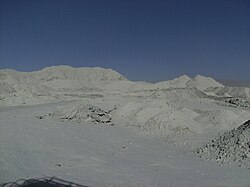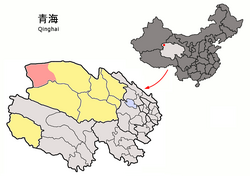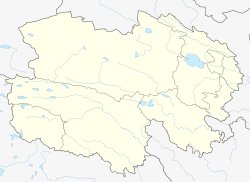Mangnai
Mangnai
茫崖 Mang'ai, Mangya | |
|---|---|
 Surroundings of the asbestos mines. | |
 Mangnai (light red) within Haixi Prefecture (yellow) and Qinghai. | |
| Coordinates: 38°15′00″N 90°51′25″E / 38.250°N 90.857°E | |
| Country | China |
| Province | Qinghai |
| Autonomous prefecture | Haixi |
| Seat | Huatugou |
| Area | |
| • Total | 49,900 km2 (19,300 sq mi) |
| Elevation | 3,000 m (10,000 ft) |
| Population (2020)[1] | |
| • Total | 18,856 |
| • Density | 0.38/km2 (0.98/sq mi) |
| Time zone | UTC+8 (China Standard) |
| Website | www |
| Mangnai | |||||||
|---|---|---|---|---|---|---|---|
| Chinese name | |||||||
| Chinese | 茫崖 | ||||||
| |||||||
| Tibetan name | |||||||
| Tibetan | མང་ནེ་གྲོང་ཁྱེར། | ||||||
| |||||||
| Mongolian name | |||||||
| Mongolian script | ᠮᠠᠨᠭᠨᠠᠢ ᠶᠢᠨ ᠬᠣᠲᠠ | ||||||
| |||||||
Mangnai, also known as Mang'ai or Mangya, is a county-level city in the northwest of Qinghai Province, China, bordering Xinjiang to the north and west. It is under the administration of Haixi Mongol and Tibetan Autonomous Prefecture. It is one of the most remote cities in China, the closest other city, Ruoqiang, is located 350 kilometres (220 mi) away.[3] In 2020 it had a population of 18856.[4] The name Mangnai is based on the Mongolian word for 'forehead'.[5]
It was formed in 2018 when the Mangnai and Lenghu administrative zones merged to establish the county-level city of Mangnai.[5]
Economy
[edit]Mangnai had a large asbestos mine, it was the largest in China, it also holds around half of China's serpentine reserves.[6][7][8] It also produces oil, natural gas, celestite, and sodium sulfate.[5]
Administrative divisions
[edit]Mangnai is divided into 3 towns. The administrative center is the Huatugou Town.[5]
| Name | Simplified Chinese | Hanyu Pinyin | Tibetan | Wylie | Mongolian (traditional script) | Mongolian (Cyrillic) | Administrative division code |
|---|---|---|---|---|---|---|---|
| Towns | |||||||
| Huatugou Town | Huātǔgōu Zhèn | ཧྭ་ཐུའུ་ཀུའུ་གྲོང་རྡལ། | hwa thu'u ku'u grong rdal | ᠡᠩᠭᠡᠷᠲᠦ ᠪᠠᠯᠭᠠᠰᠤᠨ | Энгэрт балгас | 632803100 | |
| Mangnai Town | 茫崖镇 | Mángyá Zhèn | མང་ནེ་གྲོང་རྡལ། | mang ne grong rdal | ᠮᠠᠩᠨᠠᠢ ᠪᠠᠯᠭᠠᠰᠤᠨ | Магнай балгас | 632803101 |
| Lenghu Town | Lěnghú Zhèn | ལེན་ཧུའུ་གྲོང་རྡལ། | len hu'u grong rdal | ᠬᠦᠢᠲᠡᠨ ᠨᠠᠭᠤᠷ ᠪᠠᠯᠭᠠᠰᠤᠨ | Хүйтэн нуур балгас | 632803102 | |
Demographics
[edit]17 different ethnic groups live in the city, including the Han Chinese, Mongols, Tibetans, the Hui, Salars, Monguors, Manchus, Dongxiangs, and Uighurs.[4]
Climate
[edit]| Climate data for Mangnai, elevation 2,945 m (9,662 ft), (1991–2020 normals) | |||||||||||||
|---|---|---|---|---|---|---|---|---|---|---|---|---|---|
| Month | Jan | Feb | Mar | Apr | May | Jun | Jul | Aug | Sep | Oct | Nov | Dec | Year |
| Mean daily maximum °C (°F) | −3.2 (26.2) |
2.2 (36.0) |
8.1 (46.6) |
14.0 (57.2) |
17.9 (64.2) |
21.6 (70.9) |
24.1 (75.4) |
23.8 (74.8) |
19.1 (66.4) |
11.9 (53.4) |
4.2 (39.6) |
−2.3 (27.9) |
11.8 (53.2) |
| Daily mean °C (°F) | −10.7 (12.7) |
−5.8 (21.6) |
0.1 (32.2) |
6.0 (42.8) |
10.5 (50.9) |
14.7 (58.5) |
17.1 (62.8) |
16.5 (61.7) |
11.6 (52.9) |
3.9 (39.0) |
−3.7 (25.3) |
−9.6 (14.7) |
4.2 (39.6) |
| Mean daily minimum °C (°F) | −17.4 (0.7) |
−13.1 (8.4) |
−7.5 (18.5) |
−1.8 (28.8) |
3.2 (37.8) |
8.0 (46.4) |
10.8 (51.4) |
9.9 (49.8) |
4.7 (40.5) |
−3.4 (25.9) |
−10.6 (12.9) |
−16.0 (3.2) |
−2.8 (27.0) |
| Average precipitation mm (inches) | 0.8 (0.03) |
0.6 (0.02) |
0.8 (0.03) |
1.5 (0.06) |
6.1 (0.24) |
11.5 (0.45) |
13.6 (0.54) |
7.8 (0.31) |
4.5 (0.18) |
0.8 (0.03) |
0.1 (0.00) |
0.3 (0.01) |
48.4 (1.9) |
| Average precipitation days (≥ 0.1 mm) | 0.9 | 0.8 | 1.0 | 1.4 | 3.0 | 5.9 | 7.3 | 4.1 | 1.7 | 0.9 | 0.4 | 0.5 | 27.9 |
| Average snowy days | 1.6 | 1.5 | 2.0 | 2.3 | 1.8 | 0.2 | 0 | 0 | 0.1 | 1.2 | 0.6 | 1.3 | 12.6 |
| Average relative humidity (%) | 36 | 28 | 24 | 23 | 26 | 32 | 36 | 32 | 30 | 28 | 30 | 37 | 30 |
| Mean monthly sunshine hours | 227.3 | 224.8 | 263.2 | 275.2 | 285.9 | 261.4 | 263.9 | 270.2 | 270.0 | 282.3 | 239.7 | 223.5 | 3,087.4 |
| Percent possible sunshine | 74 | 73 | 70 | 69 | 64 | 59 | 59 | 65 | 74 | 83 | 80 | 76 | 71 |
| Source: China Meteorological Administration[9][10] | |||||||||||||
Tourism
[edit]The main touristic sites in Mangnai are:[5]
- Emerald Lake (Chinese:
翡翠 湖 ) - Qianfo cliffs (Chinese:
千 佛 崖 ; lit. 'thousand Buddha cliffs') - Gasi Lake (Chinese: 尕斯
湖 ) - Yingxiongling Danxia Landform (Chinese:
丹 霞 地 貌英雄 岭) - Alar Wetland (Chinese:
阿 拉 尔湿地 ) - Yardang landform (Chinese:
雅 丹 地 貌)
In 2019, a camp meant to simulate conditions on the planet Mars opened in the town of Lenghu, which is primarily geared towards tourists.[11]
Transport
[edit]Mangnai is located strategically on one of the main transport corridors between Gansu and Xinjiang. The Haixi Huatugou Airport serves Mangnai and the city is served by the Golmud–Korla railway and is located along China National Highway 315.[3]
Notes
[edit]- ^ In Central Plains Mandarin it is pronounced Mang-ngai, a transcription of Oirat Mongolian Mangnai. In Standard Mandarin, ngai develops into two different readings with ya the most common one and ai used almost exclusively here. There's a tendency to pronounce it as ya in this situation as well.
References
[edit]- ^ "
海 西 州 第 七次全国人口普查公报(第 二 号 )——各市 县、行 委 常住 人口 情 况" (in Chinese). Government of Haixi Prefecture. 2021-07-02. - ^ "Mangya government". Archived from the original on 2021-05-27. Retrieved 2021-07-27.
- ^ a b "
最 "寂寞 "的 城市 ,成立 仅3年 人口 不 到 7万 ,就在我国 西部 ". - ^ a b 茫崖
市 人口 数 据 [Mangnai Population Data]. www.hongheiku.com (in Chinese). 2021-08-22. Archived from the original on 2021-10-19. Retrieved 2021-10-19. - ^ a b c d e 茫崖
市 简介 [Mangnai Overview]. www.mangya.gov.cn (in Chinese). Mangnai Municipal People's Government. 2019-02-28. Archived from the original on 2021-05-27. Retrieved 2021-10-19. - ^ New China Quarterly. New China News Limited. 1987.
- ^ Mineral Deposits of China. Geological Publishing House. 1990. ISBN 978-7-116-02077-1.
- ^ Wu, Lan’er (2021). Comprehensive Utilization of Magnesium Slag by Pidgeon Process. Springer Nature. ISBN 978-981-16-2171-0.
- ^
中国 气象数 据 网 – WeatherBk Data (in Simplified Chinese). China Meteorological Administration. Retrieved 27 September 2023. - ^
中国 气象数 据 网 (in Simplified Chinese). China Meteorological Administration. Retrieved 27 September 2023. - ^ Chen, Laurie (2019-03-04). "China opens 'Mars camp' for tourists, plans to send rover to red planet". South China Morning Post. Archived from the original on 2021-10-19. Retrieved 2021-10-19.

